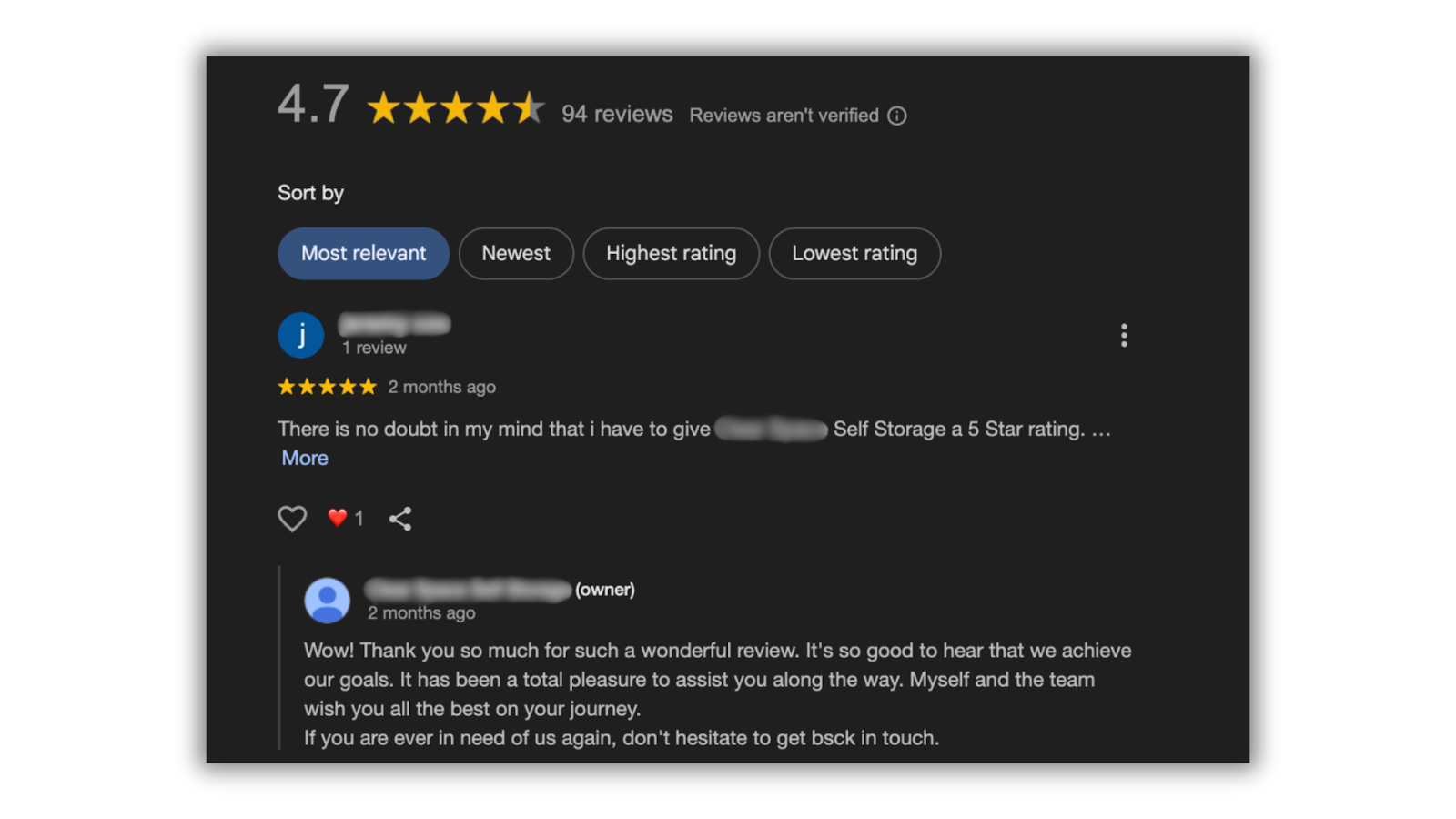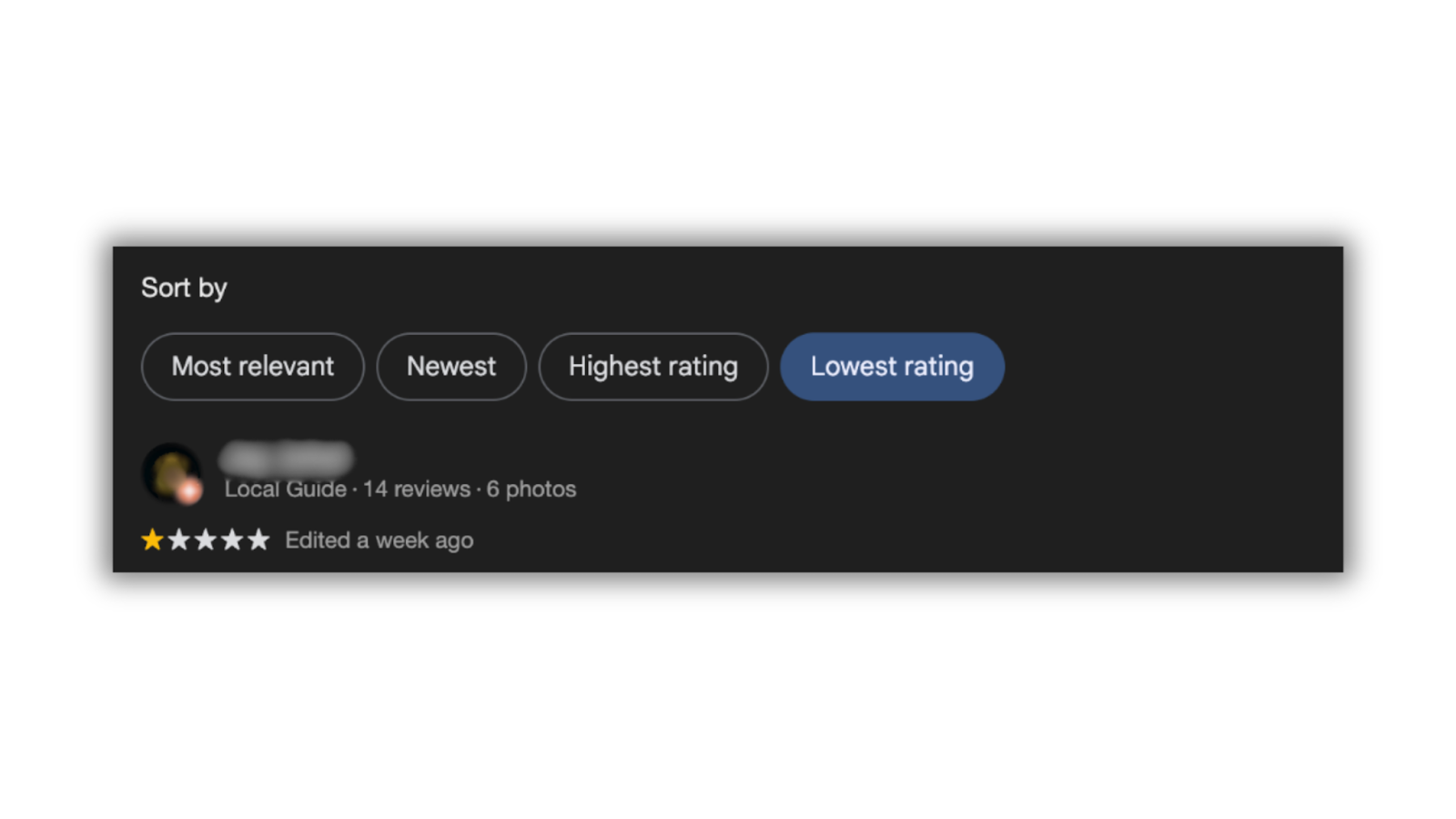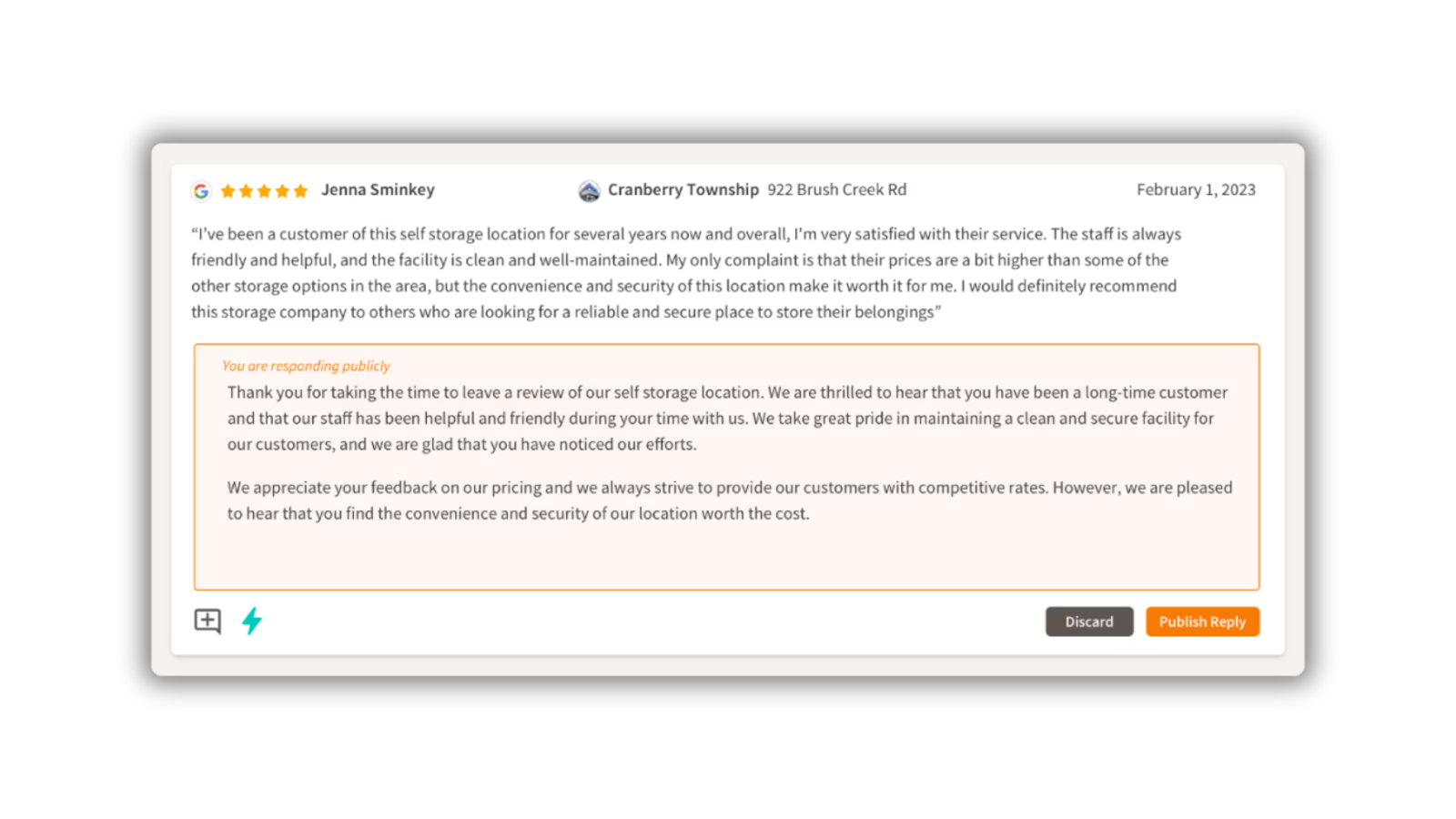
Customer Experience
Self Storage Review Management: What We’ve Seen From Facilities That Get It Right

Self storage review management is immensely important because it can influence prospective tenants in three major ways:
- Confidence builds when existing tenants confirm a facility’s reliability.
- Doubt creeps in when silence fills the review section.
- Trust erodes quickly when negative reviews go unanswered.
Rightly or wrongly, we know that prospective tenants put a lot of weight on online reviews.
When we speak with facility operators, they tell us that online reviews have influenced their occupancy rates and pricing power.
We’ve noticed that online facilities with strong feedback can hold higher rates and still see a steady stream of move-ins. In other words, they have a consistent demand.
Facilities with a shaky online reputation often find themselves competing on price, which is never good.
So, what does proactive self storage review management actually look like?
How Do Operators Usually Fall Short With Self Storage Review Management?
We’ve seen that many facilities treat review management as an afterthought.
Staff focus on day-to-day operations, while online conversations about the facility happen in the background.
A tenant might leave a glowing review, but nobody from the facility acknowledges it.
The lack of response is going to shape perception.
This is especially the case for negative reviews.
If you receive a scathing review on Google from a previous tenant and you fail to acknowledge it with a response, you’ll leave prospective tenants wondering why.
Prospects are scanning these reviews whether you want them to or not.
They want reassurance that the experience they see online matches what they will receive in person.
What Happens When Negative Reviews Dominate?
A single angry review can outweigh a page of positives.
I’ll often sort reviews on Google by those who have given the lowest ratings.

It’s something I instinctively do, which stems from curiosity more than anything else.
Most prospective tenants think similarly.
Readers remember sharp criticism more vividly than bland praise.
If the operator ignores a negative review on Google or Trustpilot, the damage is going to compound.
Even tenants who have seen no issues with the facility may hesitate to book because the negative review sits unchallenged.
Suddenly, the facility’s reputation has drifted out of the operator’s hands.
Here’s how we recommend getting things back on track:
- Offer a swift, professional response to the review.
- Contact the reviewer directly to see if you can mend the relationship.
- Discuss the points raised in the negative review with your facility team.
As you know, it’s often difficult to remove reviews on Google and Trustpilot.
You can report fake or malicious reviews, but it’s not possible to remove negative reviews from legitimate customers providing honest accounts of their experiences with your facility.
Prospective tenants who see an operator reply with clarity and accountability often view the situation differently.
The issue seems contained, and the facility looks responsive.
How Does Automation Change The Process?
With Google and Trustpilot, you typically get email notifications when new reviews are posted.
The problem is, these emails get lost easily.
After reading the reviews, procrastination creeps in, and writing responses gets pushed aside.
We see it happen all the time.
AI-driven tools now help facilities manage reviews without devouring staff hours.
You can have alerts arrive instantly when new comments appear across different platforms.
Many of these tools will generate draft responses for staff to edit and approve.

With swivl’s new “reviews” section, you can keep track of and reply to Google reviews without ever leaving the platform.
Want to write your own responses? Go for it.
Prefer to have AI step in? We’ve got that covered too.
Staff no longer jump between disjointed tools.
Everything fits inside one ecosystem.
The impact shows up quickly in a few ways:
- Reviews accumulate more steadily.
- Responses become more consistent.
- Prospects see an active and responsive facility.
From their perspective, activity in your review feed signals life, whereas silence shows neglect.
We think it’s a useful exercise to take a step back, put yourself in the shoes of a prospective tenant, and look at your review feed with brand new eyes.
What are they seeing? What don’t you want them to see?
These are the questions you need to ask.
What We’ve Seen From Facilities That Prioritize Reviews
Operators who invest in systematic review management have a much tighter grip on their reputation.
When customers write reviews, they learn about them immediately and have templated responses ready to go.
As a result, these facilities:
- Appear more trustworthy to prospects.
- Convert inquiries faster.
- Retain tenants for longer.
The teams never find themselves scrambling to repair their online reputation because they never allow it to deteriorate in the first place.
They are ahead of the game.
Positive reviews also double as free marketing.
This is why swivl and spot.is makes it easy for existing tenants to quickly write reviews.

Teams can then use these tenant comments for:
- Advertising campaigns
- Landing pages
- Social media content
The facility’s best advocates often turn out to be satisfied renters who simply shared their experience online.
Don’t Collect Tenant Reviews All At Once
Generally speaking, review collection works best when it becomes a daily habit rather than an occasional push.
Campaigns that flood platforms with reviews for a week look artificial, and the spike fades quickly.
Prospective tenants see through this type of thing.
A steady flow of reviews looks more organic and creates stronger long-term credibility.
Build this up over weeks and months.
Prospects scanning recent comments can see that the facility is active, responsive, and reliable at all times.
Consistency also helps balance out the occasional negative review.
When positive feedback flows regularly, isolated criticism becomes less dominant.
In the case of Google, negative reviews fade into irrelevance when positive reviews outweigh them.
Newer reviews are typically shown at the very top.
Unless searchers are specifically filtering for negative reviews, they will have to scroll quite far through your reviews before finding a negative one.
Prospects weigh the negative comments against a broader pool of satisfied voices.
In most cases, what you’ll notice over time is that the weight shifts in the facility’s favor.
Reviews Tell The Story Of Your Facility
Reviews on Google and Trustpilot will shape trust, influence occupancy, and feed into pricing power.
Ignoring them means surrendering control of your reputation to chance.
We know operators are stretched thin, and review management may feel like one more burden.
That’s where automation and smart workflows with swivl and other tools provide relief.
They keep feedback organized, responses consistent, and tenant voices amplified in the right way.
The facilities that thrive in the years ahead will be the ones that treat review management as a pillar of operations.
Book a demo of swivl and find out how facility teams are using conversational AI to improve tenant experiences and collect reviews quickly.















